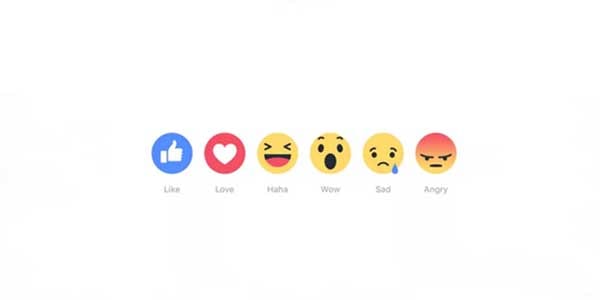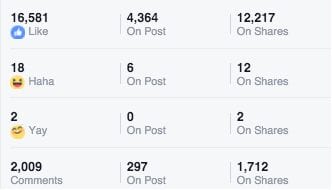 Facebook finally unveiled Facebook Reactions, the expanded Like button reactions, around the world. For the first time, you’ll now be able to react to friends’ posts with something other than a “Thumbs Up.” Testing began in Spain and Ireland late last year and, through that testing, two reactions were deleted: “Yay” and “Confused.” The test confirmed that the remaining reactions could be rolled out universally: Like, Love, Haha, Wow, Sad, and Angry.
Facebook finally unveiled Facebook Reactions, the expanded Like button reactions, around the world. For the first time, you’ll now be able to react to friends’ posts with something other than a “Thumbs Up.” Testing began in Spain and Ireland late last year and, through that testing, two reactions were deleted: “Yay” and “Confused.” The test confirmed that the remaining reactions could be rolled out universally: Like, Love, Haha, Wow, Sad, and Angry.
Here’s what it means for brands (click to tweet):
Brand Use:
Reactions WILL be available for both individual and business pages. So, if you want to angry-bomb a bad advertisement in your News Feed, there’s nothing to prevent you from doing so; however, Facebook says it will keep an eye on any misuse of reactions. What does this mean?
- You will need to put an even greater emphasis on your Facebook content. Previously, bad content could simply be ignored. Now, the large percentage of silent users may find a voice and start becoming more vocal on your page. This may allow customer service teams to get much more realistic feedback. Adding these “emotional” responses will allow brands to spot trends in customer sentiment as well as give them the ability to react to customers that express sadness or anger.
- You will need to start monitoring what prompts positive vs. negative reactions to your content and work towards adjusting accordingly.
- You will need to refine your Facebook ad targeting. If your boosted content consistently generates negative reactions, ensure you are boosting to the correct target.
Facebook Insights:
So, if you manage a brand page, can you find out what content is getting a positive or negative reaction? How will Facebook Ad Manager treat these new reactions?
- Clicking on any “reaction” button will still count as a Like in the Facebook algorithm. According to Facebook, “Because they’re treated as Likes in the back end, any engagement with it is treated as engagement in our system, the same way it has been with Likes. So, the value we assign to it in our algorithm for ads and for organic posts is going to be the same, ultimately, in the system to start.”
- This is unlikely to continue for long however. If a user clicks Angry on a branded post, brands will likely have the ability to exclude them from targeting options.
- Reaction data currently shows up in the insights panel, but not on exported data. Again, expect this to change in the coming weeks.

Prepare Content:
You should prepare content for this functionality if you have a brand that:
- Stresses emotional benefits in their product positioning.
- Makes products used in sad or difficult situations.
- Evokes a core user base of people that love your brand or product.
- Utilizes big data. Over the coming weeks, there will be scores of data on how people are using the new reactions and the type of content that elicits those reactions. Companies that operate with big data can capitalize on this news by conducting their own analysis.
Watch and Learn:
Watch and learn from PEOPLE and brands during the next few days. We will most certainly see posts from people either trying to elicit clicks or talk about it.


